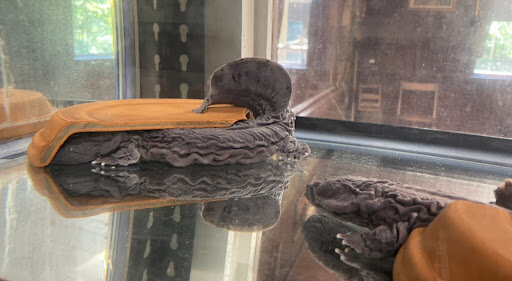The Remarkable Hellbender
Somewhere in West Virginia’s northern panhandle, there’s a room full of aquariums. They contain neither bubbling treasure chests nor tropical fish. The tanks’ residents come in various ages and sizes, but they have one thing in common: they’re all hellbenders.
What are hellbenders?
The hellbender is North America’s largest salamander and the fourth largest in the world. Two American subspecies exist: the Ozark hellbender and the eastern hellbender. The latter is found in Appalachia and is listed as “near threatened.”
Hellbenders are dark and wrinkly and slippery, earning them the nickname “snot otter.” They’re often confused with the Mud Puppy, which breathes through its gills; the hellbender breathes through its skin. Endemic to West Virginia, they were originally found in over 30 Mountain State streams. But due to habitat loss, that number has shrunk to around ten. Many of these remaining streams run through the Monongahela National Forest, where their habitat is protected from development. You’ll also find them in Ohio River Valley streams in the northern part of the state.
While few people will argue for the aesthetic appeal of the hellbender, they’ve become one of West Virginia’s unofficial symbols (the official state amphibian is the Northern Red Salamander), and those who frequent Tucker County fondly remember Hellbender Burritos as a favorite stop. You might say the hellbender is the most West Virginia kind of critter: like us, it’s oddly shaped, uniquely proportioned, and appealing in a that’s-kinda-weird way.
Hellbender conservation efforts
Hellbenders live under rocks in our healthiest streams, and they’ve got a 50-70 year lifespan. In addition to pollution and habitat loss, sedimentation in the river—that is, the accumulation of soil particles from erosion and development—is their primary threat. There are a handful of facilities in the east working on hellbender conservation, including the Oglebay Good Zoo in Wheeling. It’s the only Association of Zoos & Aquariums-accredited zoo in West Virginia, and one of its foremost conservation projects is a hellbender breeding program. The Good Zoo was the first in the world to hatch hellbender eggs, all collected from West Virginia streams and safely reared in captivity. They’ve raised over 2,000 hellbenders, 800 of which have been released back into the wild. The zoo’s hellbenders have an above average survival rate. In one stream near Wheeling, 40 percent survive. The norm is 25 percent.
Dr. Joe Greathouse is the zoo director as well as an educator in nearby West Liberty University’s Zoo Science program. He and his students work to ensure successful reintroductions.
“The biggest challenge[s] … are carnivore predation, particularly raccoons,” he said. “And then, heavy storm surges. So, when we have a storm come through all of a sudden, that produces a ton of rain. It'll move the gravel and the sediment and cover the rocks that [hellbenders are] under and essentially suffocate them since they breathe through their skin.” Sedimentation can be a result of development, both urban and agricultural. Trees stabilize the bank, and when they’re removed, erosion accelerates. Their shade keeps the water from warming up—once it climbs above 72 degrees Fahrenheit, hellbenders stop eating. Greathouse adds that while they are protected by the state of West Virginia, poachers do take individuals illegally.
One area of West Virginia in particular concerns him.
“The southwestern part of the Ohio River Valley is probably our greatest concern, where we may see the loss of some additional streams [due to] sedimentation. With the changing climate, it's going to get warmer coming up through that part of the state before it hits the rest of the state. Historically they were in Wayne County and Cabell County. And we haven't found anybody down there. Probably 20-something years.”
In addition to releasing individuals, Greathouse and his students have placed concrete nest boxes in some local streams to create more shelter. The common practice of moving rocks and cairn-building can have a deleterious effect on hellbenders. The disturbance can kill larvae and juveniles as well as their food supply—crayfish and small fish.
Even with the Good Zoo’s conservation efforts in concert with several other facilities in the east, tracking hellbenders long term is tricky. Catching 50- to 60-year-olds in a stream means only that hellbenders did well six decades ago. It doesn’t give an accurate picture of current reproduction rates.
“There may not have been any reproduction for 20 years,” Greathouse said. Today’s findings may give researchers a picture of the population 20 years down the road, which is why the zoo’s efforts are so vital today.
In the Good Zoo’s hellbender room, Greathouse’s students work the lunch duty. Each animal gets fed—the meal of choice is frozen mice—but they don’t all take the bait willingly. Students might spend hours dangling food in front of their charges, who can be persnickety or gluttonous. Hellbender personalities differ, and many of them have been safely growing in the zoo’s care for a long time. Some tanks date back to 2014.
How You Can Help
Greathouse said the most important thing is cleaning up streams and rivers. He’s found hellbenders in tires. Recycling helps keep plastic and aluminum out of their habitat. Planting trees is incredibly beneficial. And if you hook one, cut the line—the hook should dissolve over time. Greathouse also suggests buying the West Virginia wildlife diversity license plate because those funds support nongame conservation. And, of course, volunteer where you can, and bring your family along. Greathouse noted that kids are especially drawn to aquatic life.
“One of the places on the Cheat River where we go is near a state park, and the kids are just fascinated when you pull hellbenders out of the water,” he said. “And you show them some of the stuff that you do as part of the research, but they're just fascinated that something like that was in the river where they were swimming. And it's impressive to show them that and see how excited they are.”
This is great news for the hellbenders. Education may be the most important tool we have for ensuring their success. Indeed, their future is in these children’s hands.
Special thanks to Dr. Joe Greathouse and his students for their time and enthusiasm.




